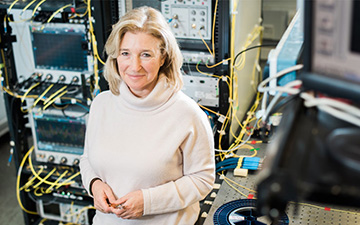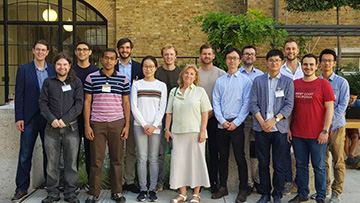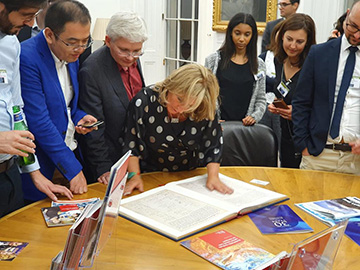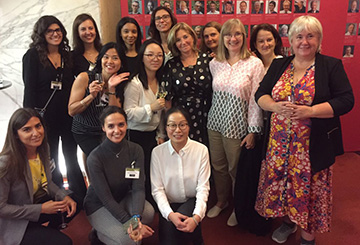
Polina Bayvel. [Image: UCL Department of Electronic and Electrical Engineering]
Twenty-five years ago, the Optical Networks Group (ONG)—a path-breaking research effort at University College London (UCL) under the leadership of OSA Fellow and 2020 Board member Polina Bayvel—first opened its doors. In the ensuing two and one-half decades, the group has taken on a wide swath of problems in optical communications, ranging from foundational work in wavelength-division multiplexing (WDM) to the ultimate capacity of nonlinear fiber channels and the current drive for “intelligent” networks and transceivers.
An anniversary workshop last week struck some of the keynotes that will guide the lab’s research in its next 25 years—and suggested, according to Bayvel, that there remains “a lot more to do.” OPN caught up with Bayvel after the workshop to learn more about ONG, its history and its future.
Industry-academic nexus
Bayvel first conceived the idea of ONG while she was working in industry in the early 1990s, at Standard Telecommunications Laboratories (STL). Acquired in 1991 by Northern Telecom and subsequently folded into its Bell-Northern Research (BNR) arm, STL was the storied lab at which Charles Kao and others had done work on low-loss glass that contributed to the development of optical-fiber communications (and that earned half of the 2009 Nobel Prize in Physics for Kao).
Bayvel wanted to bring in-depth analysis to the work she had seen in industry labs, in an academic setting, to address fundamental questions. “Having worked in the optical network and optical communications area,” she says, “I saw that often the push from industry doesn’t allow fundamental research areas to be explored rigorously.” Yet academic environments often lacked industry-scale infrastructure for real-world testing of ideas incubated in the lab.
To bring the two together, Bayvel applied for, and won, a Royal Society University Research Fellowship, which provides five years of funding for early-career postdoctoral researchers free of teaching or administrative responsibilities. Recently, she recalls, in advance of the 25th anniversary celebrations for ONG, she “dug out my original research proposal” to see what she actually had planned to do under the fellowship.
“Sometimes, you look later at what you wrote in a proposal, and say, ‘What was I thinking?’,” she laughs. But in this case, it turns out, the proposal very accurately captured what Bayvel would ultimately pursue and accomplish. “I said that I wanted to set up an academic systems engineering group, and I wanted to establish an experimental testbed, to be able to experimentally verify theoretical predictions.”
Building the testbed
![]()
Bayvel talks with Domanic Lavery—then a Ph.D. student, and now an ONG research fellow and lecturer—in the lab. In the background is former ONG postdoc Robert Maher, now with Infinera. [Image: Courtesy of Polina Bayvel]
To turn what was then an audacious vision into a reality, in 1994 Bayvel took her initial Royal Society grant to the UCL Department of Electronic and Electrical Engineering—an organization with a rich history of its own. It had been founded in the late 19th century by John Ambrose Fleming, the first professor of electrical engineering in England; Fleming, among many other things, designed the radio transmitter–receiver that would be used by Guglielmo Marconi to send the first radio transmission across the Atlantic Ocean. When Bayvel arrived at the department, it was chaired by John Midwinter, himself a legendary figure in optical-fiber communications who had earlier come to academia after a career at British Telecom.
At the time Bayvel started ONG at UCL, she says, there was “no such lab in existence in the U.K.” at a university. “I was starting out a research group [in academia] to compete with big industrial labs.” Midwinter warned her that such an undertaking was going to “cost a lot of money,” and asked her where it was going to come from. Bayvel’s answer: She was going to apply for grants.
And that is precisely what she did. “Slowly, grant by grant,” she recalls, “we managed to set up a testbed”—a recirculating fiber loop that could support WDM in 4×2.5-gigabit-per-second channels (which was later upgraded to 10 Gb/s, and today operates at terabit-per-second rates). The testbed positioned the lab, she says, to “explore the different aspects of evolving optical communication systems.”
Fleshing out WDM
And there was plenty at that time to explore—beginning, according to Bayvel, with the limits of WDM itself, a technique that ultimately became central to today’s broadband data communications but was then in its infancy.
“Now we take WDM for granted,” she says. “But at the time, there was a debate as to whether WDM was a feasible technology.” Fundamental questions included whether lasers could be made stable enough to generate the closely spaced channels required for WDM, and whether multiplexer/demultiplexers could be made with high enough resolution to handle the required wavelength splitting and re-integration with acceptable error rates. Another research direction was nonlinear interactions in optical fibers and their impact on communications.

Bayvel (center) with some members of the current ONG research team. [Image: UCL Department of Electronic and Electrical Engineering]
The budding ONG research team used its testbed to help answer those questions and to set out the required specs for devices that could support the new WDM communications system. From there, the group fanned out to tackle new problems in WDM transmission and wavelength routing, coherent detection, digital signal processing and other areas. In the past decade, ONG has focused in particular on “trying to understand the ultimate capacity of information that can be sent down a nonlinear optical fiber,” Bayvel says.
“The optical-fiber channel is a nonlinear channel,” she observes, “and to our surprise,” while the behavior of linear channels is cogently described by the well-known Shannon limit, “for a nonlinear channel it was not completely understood.” A better understanding of those limits, she adds, has set the lab up for understanding how they play out in overall throughput of large networks.
Toward intelligent networks
That understanding of optical network capacity limits also underlies a key focus of the lab’s current work: determining how some of the those limits can be addressed by using so-called adaptive networks. These are networks that can shape network capacity on the fly to match the loads being placed on the network at a given time. The key to such networks, and a current focus of ONG’s efforts, is the design of “intelligent transceivers,” that, as Bayvel puts it, can “sense their environment and configure themselves to their environment, a little bit like self-driving cars.”
The group is also exploring whether, and how, capacity might be expanded by taking advantage of more of the bandwidth available in the fiber. “The throughput of a fiber link has been determined for a number of years by the bandwidth of the erbium-doped fiber amplifiers—about 70 to 90 nanometers,” she points out. “But in fact we have something like 300 nm of channel bandwidth available. Can we access that bandwidth, and what kind of devices would we need to do that?”

At the ONG 25th anniversary celebration, attendees explored the 350 years of science history embodied in the Royal Society Fellows Book, where fellows of the society sign their names once elected. [Image: Courtesy of P. Bayvel]
A 25th-anniversary bash
These questions and others offered plenty of grist for debate at a 19-20 September workshop, “Optical Networks: The Next 25 Years,” organized by Bayvel and a colleague, ONG alumnus Ben Puttnam of NICT in Japan, to celebrate the group’s 25th anniversary. Bayvel notes that the workshop attracted many of the roughly 100 persons that she estimates have been associated with ONG since its founding. Indeed, she sees these people as perhaps the most consequential outcome of the group’s founding and history. The quality of people the group has been able to attract, she stresses, has “helped to make ONG what it is today.”
“We’re very proud of the research results, of course,” Bayvel says. “We count a large number of firsts in a very fast-moving, competitive research area. But the key contribution, I think, is the people. This group is a family.” And those people, she adds, are “the ones who are now leading and defining the field” at leading companies and academic labs. “I can’t think of a communications company where we don’t have an ONG graduate, visitor or former postdoc … and I’m in touch with practically every single one of them.”
Of particular satisfaction has been the experience of her first ONG postdoc, Robert Killey, whom she describes as her closest collaborator for more than 22 years. “He’s just been promoted to full professor,” Bayvel reports. “And as part of the celebration, we had his inaugural lecture.”

Women ONG members and other women active in optics at the 25th anniversary celebration, including Bayvel (center) and UCL Electronic and Electrical Engineering department head Sarah Spurgeon (right). [Image: Courtesy of P. Bayvel]
Lots of room to explore
Regarding the scientific content of the ONG anniversary workshop, Bayvel says the take-home message is that there’s still a vast space of interesting and important problems to explore in optical communications and networks. “The optical network is not just optical pipe,” she explains. “To support the growth of new services and new applications, which require more bandwidth, we need to use them more intelligently than we’ve been doing.”
The workshop offered ample opportunities to discuss the best ways for accomplishing that goal—not only through the design of new devices and the exploitation of more of the available fiber bandwidth, but through integrated approaches incorporating plasmonics and silicon photonics. The event also dug into questions such as the role of data centers, and even how to eliminate time delays in the fiber network. “If you want to operate at a distance—to do brain surgery at a distance, say—you need to eliminate the delay,” she notes. “How can you do this?”
To Bayvel, these and other topics raised at the anniversary workshop suggest that ONG’s next quarter-century of work could prove as interesting as the first one. “Nobody went away depressed,” she says. “We’re not going to be out of a job in the foreseeable future.”
* * *
OPN thanks Polina Bayvel for her time and enthusiasm in helping us tell this story. She adds that she is “hugely grateful” to the Royal Society, which supported her work for more than 15 years, and to the U.K. Engineering and Physical Sciences Research Council and multiple companies “who have provided funding for this very capital-intensive research area.”
Bayvel also wishes to thank her mentors former UCL department heads Sir Eric Ash, Sir David Davies and John Midwinter for their support; and former and current ONG P.I.’s and faculty members, including Lidia Galdino, Robert Killey, Dom Lavery, Zhixin Liu, Seb Savory, Benn Thomsen, Phil Watts and George Zervas, as well as former and current students and researchers.
